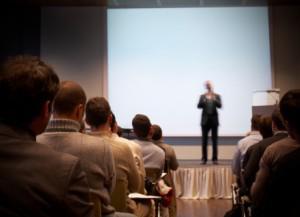The New Normal: The Changing Communications Landscape
The need to explore new models was the emerging theme of the Colloquium. I’d like to take us up to 20,000 feet for a minute and talk about the new model of communications and the media landscape that is the new normal.
How many of you use Facebook personally?
Compare this 30% to this number: 96% of your target audience, people aged 18 to 35, is on social networks. The important thing, however, isn’t whether they are using Facebook or MySpace. It is that these 96% are actively engaging in the online creation, distribution, and sharing of information and media.
The ability to do these things through technology is an enormous change; the biggest shift since the industrial revolution. It has significantly changed our every aspect of our daily lives at home, work, school, and play and has subtle but profound psychological implications at all levels of society.
Lectures and Cocktail Parties 

Consider the difference between a lecture and a cocktail party. The old communications model —the mass communication, broadcast model — was like the lecture.
- A lecture is unidirectional and linear.
- Only one person gets to talk at a time
- You are supposed to stay in your chair and be quiet
- The lights are on the stage
- There is one message for everyone
- They aren’t very social, but you might get to meet the guy in the chair next to you
- Someone besides you decides when it’s over
- At the end, you’re supposed to feel grateful and applaud.
Now, we live in a globally networked world. We are connected many-to-many. We have left the lecture hall and gone to a cocktail party.

- A cocktail party is full of conversations.
- They are noisy and full of energy.
- Everyone talks at once
- They are dynamic and social. You move around the room, talk to new people and meet ones you haven’t met before
- The lights shine on everyone equally
- You get to choose when and what to eat or drink and who to talk with
- You can decide when it’s over for you and
- When you leave, the host thanks you for coming.
Most of the people who are thinking about college today have grown up in the cocktail party model.
This doesn’t mean they are foolish and frivolous or drink too much. It doesn’t mean they have short attention spans or are ‘addicted’ to social media. It means they have grown up with the assumption of their ability to have 24/7 connectivity and on-demand access to information and people.
Individual Expectations and Beliefs
We all have basic beliefs about how the world works and our place in it that are formed from our day-to-day experiences. Since the introduction of public access to the Internet in the mid 1990s, technology has significantly changed those day-to-day experiences compared to 15 years ago. This is the biggest shift since the industrial revolution. Technology has literally rewired the world and the way we think.

Young people today take connectivity, interaction, and participation for granted in the same way most people view electricity. Whether young people actually use the specific tools or not, they have expectations about where information exists. For example, they expect breaking news to be found on Twitter. They expect gossipy news and photos to be on Facebook. They expect instant response to text messages. They expect to phones to take pictures.
Gone are the days of ‘a single function device.’ All of us, but young people in particular, expect life to be media rich, full of images and sounds, not just text. This makes sense cognitively because multimedia delivery is the most effective way to share information, increase attention, and retention.
Young people also expect information to flow from one media to another. The distinction between online and offline is no longer relevant. They are just different forms of connecting along the continuum of life experience.
Social technologies — and there are many kinds beyond social networks, such as blogs, microblogs, wikis, file sharing like YouTube and Flickstr, tagging, forums — have fundamental characteristics that change people’s expectations about how the world works. Earlier sessions talked about meeting the expectations of foreign students in terms of academic, social and career support. But it’s not just foreign students you have to satisfy. Students everywhere have a whole new set of expectations, thanks to a networked and mobile communications landscape.
Today’s Prospective Student

Mary can have relevant information from every domain in her life delivered to her on demand instantaneously any time of the day; she can stay connected to the people and things that matter to her, and effectively interact with her world.
In other words: technology gives Mary a Results-Only Living Environment in her backpack. Every contact, every social connection, every bit of interaction provides reinforcement for her assumptions that when she acts, the world responds.
If you go back to the lecture and the cocktail party analogy, the balance of power is shifting from the sender to the receiver. There is unprecedented access, choice and reach. Social technologies fundamentally shift individual beliefs about what a person can or can’t do. This doesn’t mean that technology has erased all socioeconomic differences or equalized all access, but it has taken the entire data set and moved it to a difference place on the curve of individual agency. THIS is the new normal. From Egypt to Occupy Wall Street, people have a new sense of agency and a belief in their right to speak up. Social technologies are teaching people how to be self-motivated learners, increasing empathy, social capital, and self-efficacy.
You’re Communicators. So What Are Rules for the New Normal?
The new normal is about network systems. Networks are about relationships. Nothing is just one way. Networks are continually changing, reciprocal environments. Don’t be fooled by that fact that technology is involved. It is a vehicle not the goal.
- Relationships are about authenticity and real human contact. 78% of people trust peer recommendations; but only 14% trust advertisements directly from an organization
- In a networked world, access is easy. It’s hard to hide things. The new normal is an expectation of honesty and transparency because it’s easy to find out who’s not telling the truth
- You don’t control your message; if you’re lucky you can contribute to it by active participation
- In a world where anyone can talk to anyone, the new normal is much less tolerant of hierarchies that block access and information, or operate based on condescension or exclusion.
- In a world where the cost of publishing your opinion is zero, the new normal is participation. People expect to be able to have an opinion; they expect to contribute; they expect to be heard; AND they expect acknowledgement.
- In a digital world, the new normal redefines time and space. Responses need to be immediate, whether it’s email, callbacks, text message or shipping.
- Technology and on-demand capabilities means we pull information to ourselves based on need, we do not wait for it to be given out. The new normal is an expectation being able to access and interact with our information and the environment.
- It’s not about the tools — it’s about goals. Media choice is based on the best tool we can get for the job.
Against this broader backdrop, there are some very real differences in access and use. According to researchers, the digital divide is lessening not because of more broadband access or home computers, but because of increased adoption of mobile technologies. For example, teens from lower income families are twice as likely to use a cell phone to access the Internet. The divide will be more about technological literacy than access.
Social technologies have given people unprecedented control over their lives. We act and, because we are linked in real time, we see the actions others take and we can interact with them. Individual actions inspire group actions; groups inspire individuals.
The most exciting thing is that we are training new generations to believe they can act; to believe that an individual can make a difference. It changes everyone’s expectations about their ability— and their responsibility—to contribute.
What Does This Mean For Colleges And Universities?
Colleges and universities have to communicate value in the context of the larger world — one of global competition, rising education costs, and a challenging job market.
How we communicate has changed, both in form and function. Social technologies have not only created a new host of tools, but a new set of expectations on the part of the potential students.
The biggest challenge is getting over the old model; the image of your organization as the ‘lecturer.’ I’ve got a news for you — you can go on talking in a lecture hall but your market has figured out they don’t have to sit and listen.
- The good news is that social technologies mean you can get a lot of bang for your buck.
- The bad news is that your strategy and goals are more important than ever because
10 Guidelines for the Social Media Environment
- You have to find out where the students ARE, to be able to reach them
- Communication has to be fluid and consistent across multiple devices and platforms, from text messaging and YouTube to legacy media and face to face. Think transmedia
- You have to plan for collaboration and participation
- You have to prepare contingency plans for problems
- Go where the prospective students are and LISTEN FIRST to find out what they think need, not what you think they need
- Information has to be human, honest, and transparent
- Interactions and responses must be timely
- Attention is a scarce resource and information is plentiful. Deliver value is by synthesizing information and facilitating decisions
- The process of recruiting and admissions must allow personalization and participation (beyond sending in the application or emailing an admission’s officer questions)
- Ask your audience for solutions to your problems
Implications for Higher Education
First, as buckets of data will attest, the fundamentals that are drive opportunity, from higher compensation and employment to recognition, are always about who add value to society. When jobs are scarce, we lose track of the fact that they are scarcer the less skills and education you have.
More than any time in history, we live in a knowledge society. Technology is ubiquitous, from simple iPhone apps to complex biomedical and engineering tools. Success in the 21st century requires a new literacy. It requires the ability to apply judgment and critical thinking to see what technology allows us to do. It’s not about finding. It’s about thinking, synthesizing and innovating and converting that to action.
Colleges and universities aren’t immune to the changing environment outside the Ivy Covered Halls. Think about the difference between lecture halls and conversations, not just for how you communicate what your institution can offer or what college can offer, but in HOW you educate.
Effective education needs to be follow the same rules: collaborative, participatory, challenging, responsive, inclusive, respectful, be interesting and have value for the 21st Century.
The education offered must be relevant to the goals of the prospective student. The ability to control the environment, to participate means that the prospective student isn’t going to take your word for it that what you offer is valuable. You have to make it valuable and prove it.
The social media environment has the potential to create self-motivated learners in a responsive environment that believe they can change the world.

